Gravesite of J.C. Hall
Introduction
Text-to-speech Audio
Joyce C. Hall (better known as J.C. Hall) was one of the founders of Hallmark, a Kansas City-based greeting card company. He arrived in Kansas City in 1910 with two shoeboxes of postcards and the dream of starting a company where he could sell postcards by mail order. He was eventually joined by his older brothers Rollie and William and together, they founded the greeting card company that would become globally renowned. Along with Hallmark, J.C. and his son Donald developed Crown Center, Kansas City's "city within a city" that includes residential and office buildings, shopping, and entertainment.
Images
J.C. Hall's headstone at Forest Hill Cemetery
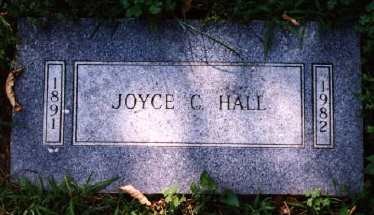
J.C. Hall at his childhood home in David City, Nebraska.
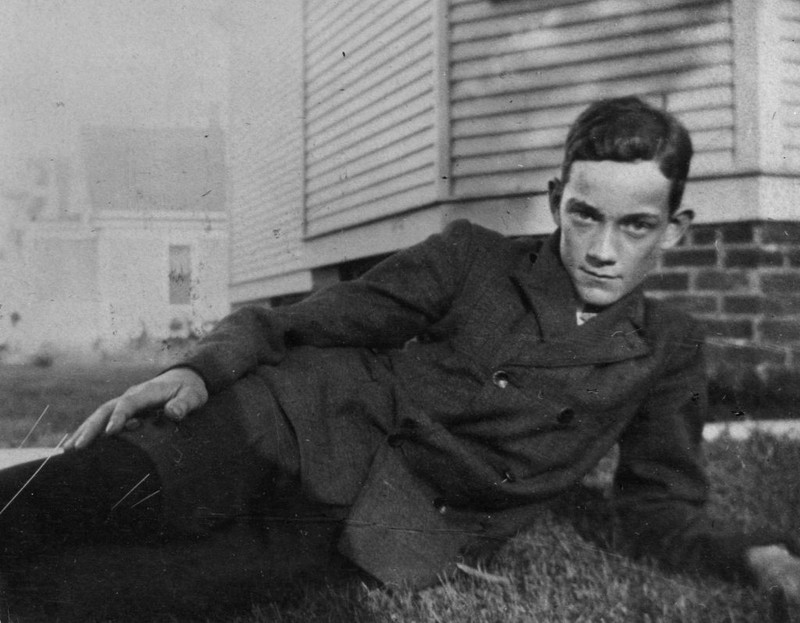
J.C. Hall (left) with his siblings at the Norfolk Bookstore.

J.C. Hall at age 18
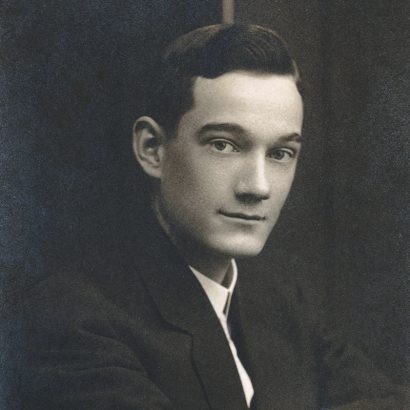
J.C. Hall
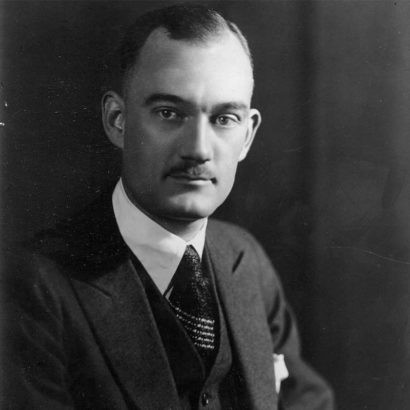
J.C. Hall and his son Donald
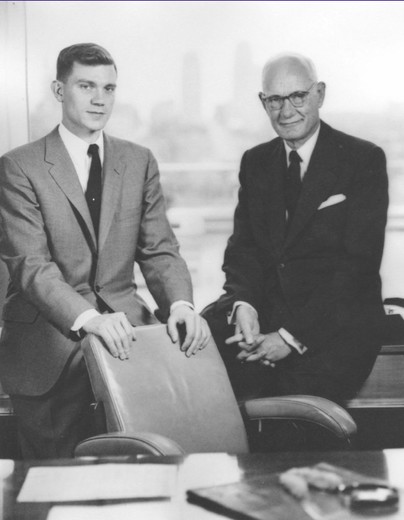
J.C. Hall and his wife Elizabeth
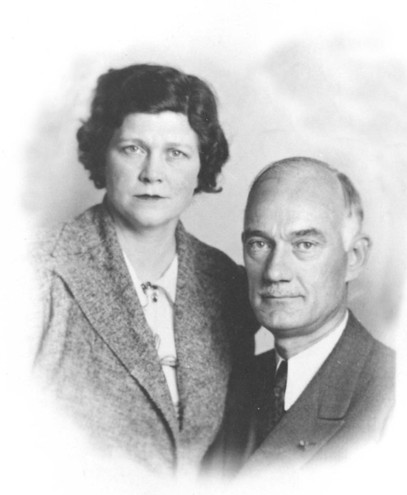
Backstory and Context
Text-to-speech Audio
Joyce C. Hall (better known as J.C. Hall) is remembered for the successful greeting card company, Hallmark, he founded with his older brothers Rollie and William. J.C. was born on August, 29th, 1891 in David City, Nebraska to George Nelson Hall and Nannie Dudley Hall. While George Nelson Hall struggled to support his family, he joined the Methodist Church in 1891 as a lay preacher. He began traveling the country as a preacher and sent very little money back home to his family, causing J.C. Hall and his brothers to grow up in poverty. The brothers began supporting the family at an early age by selling sandwiches to passengers on the train from Burlington to David City or lemonade to fairgoers and baseball fans.
At just age 9, J.C. Hall was selling perfumes and extracts for the California Perfume Company, which later became known as Avon Products. Hall’s parents were divorced in 1901, by which time he and his brothers were working for L.W. and Millie Snow, the owners of a 99-cent store in David City. The couple was very influential on the Hall brothers by introducing them to retail. Rollie and William worked at the Snow’s 99-cent store and in 1900, they followed the Snows to Columbus where they opened a bookstore. Rollie became head clerk there but a year later, decided to become a drummer (traveling salesman) for the Marshall Paper Company of Omaha. He was likely inspired to take this step by L.W. Snow, who was also a drummer. After his short stint selling paper, Rollie traded it out for a candy line under the same company, Voegle and Dinning, employed by L.W. Snow. Meanwhile, William continued to work at the bookstore in Columbus where he learned merchandising and became assistant manager. William went into business with traveling newspaperman William S. Jay in 1905 and together, they bought a bookstore in Norfolk, Nebraska that they named Norfolk Book Store. The same year, J.C. began working at the bookstore after the school year ended. The boys helped pull their family out of poverty, and they all left David City for good in 1905.
While J.C. was working at the bookstore, the postcard fad hit the United States and caught the attention of merchandisers across the nation. J.C. himself became aware of the fad during a chance meeting with a Chicago-based salesman representing a large New York-based importer of picture postcards. He relayed the story to his brother William and offered to put up all his money for the business. William was convinced after meeting with the salesman the following morning. William, J.C., and Rollie would equally contribute funds for the initial order of the firm that J.C. had already named the Norfolk Post Card Company. The brothers began selling postcards at the bookstore and they became the best-selling items in the store. By 1907, postcards were still intensely popular in the United States, causing William to decide to remodel the entire back half of the store to accommodate the inventory. The Norfolk Bookstore, which eventually became the Hall Bookstore, functioned as the postcard company’s first headquarters where J.C. fulfilled orders. They even began producing original postcards depicting local scenes in Nebraska. J.C. dropped out of high school at age 18 after traveling with Rollie as a drummer for their postcard company for a summer.
Aspiring to expand the postcard business, J.C. moved to Kansas City in 1910. He convinced his family to allow him to move by enrolling in Spalding’s Commercial College. He arrived with two shoe boxes full of postcards and sought out drugstores, bookstores, and gift shops. J.C. dreamed of opening a business where he could sell postcards by mail order, which led to him being kicked out of his room at the YMCA because he was running the business out of his room. The budding businessman decided not to return to college as his business was growing. Rollie joined him in Kansas City to help run the business and the following year, their mother Nancy and younger sister Marie followed. In 1912, the Norfolk Postcard Company was renamed Hall Brothers and they began selling greeting cards as the postcard craze died down. The following year, J.C. and Rollie rented a retail space in downtown Kansas City to showcase their product. In 1912 and 1913, they were convinced greeting cards were the way to go following a successful Christmas season. J.C. contacted a small engraving company in Kansas City to publish a line of 20 cards consisting of a variety of designs and sentiments. On the back of each card was the inscription: Hall Bros., Kansas City, MO., Made in U.S.A. With this success, the Hall brother entered the publishing business. In 1915, a fire destroyed all of the Hall brothers’ products. The same year, J.C. learned that the Smith-Pierce Engraving Company was in financial trouble and agreed to take over payments of their presses while the men were hired on to work for Hall Brothers. With the Smith-Pierce equipment and expertise as well as the women the brothers hired to hand color the engravings, the Hall Brothers became a manufacturer. By mid-1915, the company was creating and producing their own cards on their own presses – the first Hallmark cards. Initially, they were producing Christmas and Valentine’s Day cards that were mailed in envelopes to protect the consumer’s privacy.
William joined J.C. and Rollie in Kansas City in 1921 and, in 1923, began working at Hall Brothers. It was in 1921 that J.C. married his wife Elizabeth with whom he had three children: Elizabeth Ann Reid, Barbara Louise Marshall, and Donald Joyce Hall. The Hall family was invested in philanthropy, and in 1943 J.C. and Elizabeth alongside Rollie founded the Hall Family Foundation. The purpose of the Foundation was to pay back Kansas City and to promote "the health, welfare and happiness of school-age children; the advancement and diffusion of knowledge; activities for the improvement of public health; and advancement of social welfare." The Hall Family Foundation provides grants to organizations and institutions within the Kansas City Area in order to enhance and better the lives of those living in the area.
Along with William joining the company and J.C.'s marriage to Elizabeth, the 1920’s also marks the decade that J.C. began putting “Hallmark” on the back of the greeting cards, a word that he favored because it denoted quality while including the family name. The company name would officially be changed in 1954. Hallmark Cards was rapidly growing in the early 1960s and the land around their headquarters was littered with abandoned warehouses and empty buildings. In the spirit of revitalizing the city, J.C. developed a plan that included a remodel of their office building, built in 1916 as well as redeveloping the area around it. In 1966, J.C. turned his position as president over to his son Donald. Together, they carried out J.C.’s vision of revitalization and, inspired by Hallmark’s crown logo, decided to call it Crown Center. After the plans were approved by the city, J.C. and Donald formed the Crown Center Redevelopment Corporation to oversee the project and sought advice from people like J.C.’s longtime friend Walt Disney. Development began on September 16th, 1968 and the first phase was completed by 1971. This first phase included a public square with walkways and fountains. By 1973, there was a second square, the Ice Terrace skating rink, Grand Avenue Bank & Trust building, the Crown Center Hotel (not Westin by IHG), and the Crown Center Shops. Since then, Crown Center has become known as a “city within a city” that includes office and residential space, shopping, and entertainment.
Rollie and William had passed away in 1968 and 1971, respectively. Although J.C. turned his position over to his son, he remained active in the business as chairman of the board. J.C. Hall passed away at age 91 on October 29th, 1982 in his sleep at his home in Leawood, Kansas.
Sources
History, Hallmark. https://corporate.hallmark.com/about/hallmark-cards-company/history/.
J.C Hall, Hallmark. https://corporate.hallmark.com/about/j-c-hall/.
Hallmark Visitors Center, Hallmark. https://corporate.hallmark.com/about/hallmark-cards-company/hallmark-visitors-center/.
Puschendorf, L. Robert. The Halls of Hallmark, Nebraska State Historical Society. January 1st, 2014. https://history.nebraska.gov/sites/history.nebraska.gov/files/doc/blog/halls-of-hallmark.pdf#page=6.
National Register of Historic Places Nomination Form - Crown Center Historic District, Missouri State Parks. September 20th 2019. https://mostateparks.com/sites/mostateparks/files/Crown-Center-Historic-District.pdf.
Crown Center Redevelopment Corp., Hallmark Corporate. https://corporate.hallmark.com/about/hallmark-cards-company/our-businesses/crown-center/.
Page, Eric. "J.C. Hall, Hallmark Founder, is Dead." The New York Times (New York City) October 30th, 1982. , 1 sec.35.
A Legacy of Excellence, Hallmark Corporate. Accessed March 18th, 2023. https://corporate.hallmark.com/about/j-c-hall/#:~:text=Hall%20and%20his%20wife%2C%20Elizabeth,of%20directors%3A%3B%20Donald%20J..
History + Timeline, Hall Family Foundation. Accessed March 18th, 2023. https://www.hallfamilyfoundation.org/history-timeline/.
Find a Grave
Hall Family Foundation
Hall Family Foundation
Hallmark Corporate
Hallmark Corporate
Hall Family Foundation
Hall Family Foundation
